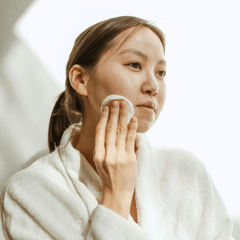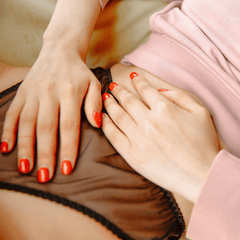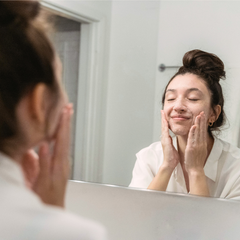Does Endometriosis Cause Adult Acne?

Struggling with stubborn breakouts and wondering if it’s connected to endometriosis? You’re not alone. Many women with endometriosis also deal with adult acne, especially the hormonal kind that seems to flare around their chin or jawline, and it’s no coincidence.
In this post, we’re breaking down the science behind endometriosis and acne, explaining exactly how they’re connected, and giving you clear action steps for what to do if you’re dealing with both. Whether you’ve been diagnosed with endo or suspect you might have it, this is the guide you’ve been looking for.
Can Endometriosis Cause Acne?
Yes, endometriosis can contribute to adult acne in women. While endometriosis doesn’t directly cause breakouts, it is associated with hormonal imbalances, particularly estrogen dominance, and inflammation, both of which can make acne worse. The connection is complex but very real, and understanding it is key to managing your skin and your health.
What Is Endometriosis?
Before diving into acne, let’s quickly cover what endometriosis is.
Endometriosis is a chronic, inflammatory condition where tissue similar to the uterine lining grows outside the uterus, often on the ovaries, fallopian tubes, or other pelvic organs. This tissue responds to hormonal changes throughout the menstrual cycle, which can lead to the following symptoms:
- painful, heavy periods (that last 7+ days)
- cramping, bloating, pelvic pain
- nausea, dry heaving, vomiting
- digestive issues, bowel disorders
- painful urination
- painful sex, fertility struggles
- ovarian cysts
- depression, anxiety, fatigue
It affects 1 in 10 women, but diagnosis can take years because symptoms often overlap with other conditions.
Why endometriosis happens is still not fully understood. There are several theories, including retrograde menstruation, immune dysfunction, and genetic predisposition, but the exact cause is still unknown.
How Do I Know If I Have Endometriosis?
If you're experiencing many of the symptoms listed above, especially severe period pain, pelvic discomfort, or digestive issues, you might be wondering if endometriosis could be the cause.
The truth is, endo can be tricky to diagnose, and many people go years without a clear answer. Here's what you need to know:
- Diagnosis requires more than symptoms. While symptom tracking is an important first step, endometriosis can only be officially diagnosed through a surgical procedure called laparoscopy, where a specialist looks for endometrial-like tissue outside the uterus.
- Imaging can help. While not definitive, transvaginal ultrasounds and MRIs can sometimes detect signs of endometriosis, especially if there are visible cysts (like endometriomas) or tissue thickening. These tools can help rule out or raise suspicion for endo before surgery is considered.
- Pelvic exams may provide clues. A gynecologist might feel areas of tenderness, nodules, or masses during a pelvic exam that suggest endometriosis, but again, this isn’t conclusive.
- It often runs in families. If your mother, sister, or other relatives have endometriosis or struggled with severe menstrual symptoms, your risk is higher.
If your symptoms are persistent and interfering with your life, it’s worth advocating for yourself. Keep a detailed symptom log, seek out a provider who takes endo seriously, and don’t be afraid to ask about a referral to a specialist.
What Are the Treatment Options for Endometriosis?
Because endometriosis is driven by hormones and inflammation, most conventional treatments aim to reduce symptoms by managing those two factors. Here’s a quick overview of the most common options:
- Hormonal Contraceptives: Birth control pills, hormonal IUDs, patches, and implants are often prescribed to suppress ovulation and regulate estrogen levels, which can help reduce the monthly flare of endo symptoms. While many people do find relief, symptoms may return once you stop taking these meds.
- Anti-Inflammatories (NSAIDs): Over-the-counter medications like ibuprofen or naproxen are often used to reduce pain and inflammation, especially during your period. While they may help manage day-to-day symptoms, they don’t slow disease progression or address deeper hormonal imbalances.
- Other Medications: More aggressive drugs like GnRH agonists or antagonists (e.g., Lupron) shut down estrogen production entirely, putting the body into a temporary menopausal state. These can reduce pain but come with significant side effects like bone loss, hot flashes, and mood changes, so they’re often used short-term.
- Surgery: Laparoscopic surgery can remove or destroy endometrial lesions, cysts, and adhesions. For many, surgery provides significant symptom relief, especially when done by an endometriosis specialist. However, it’s not a guaranteed cure, and lesions can return over time.
How Endometriosis Can Cause Acne
Women with endometriosis often have high levels of estrogen relative to progesterone. This makes sense—after all, estrogen plays a key role in uterine lining growth, which is the same type of tissue that grows outside the uterus in endo. This hormone imbalance, often referred to as estrogen dominance, can result in high levels of DHT (dihydrotestosterone), the acne-causing form of testosterone.
High DHT levels stimulate excess oil (sebum) production, especially in the skin around the chin and jawline, areas rich in hormone-sensitive receptors. The result? Clogged pores, inflammation, and cystic breakouts.
Curious about estrogen dominance? We cover symptoms, causes, and treatment options in our full estrogen dominance guide.
Endometriosis is not just hormonal, it’s also inflammatory. With this condition, the immune system is often in a chronic state of low-grade inflammation, producing prostaglandins, hormone-like compounds that can inflame acne lesions.
In short: if your immune system is overreacting, your skin often is too.

Endometriosis and Adult Acne: What the Research Says
There isn’t a ton of direct research linking endometriosis to acne, but the evidence we do have is compelling.
- Hormonal profiles of women with endometriosis often show high estrogen and low progesterone, an imbalance that commonly includes hormonal acne as a symptom.
- Other research highlights how endometriotic lesions are surrounded by highly inflammatory environments—the same types of immune disruptions implicated in acne.
The bottom line? The immune and hormonal imbalances in endometriosis are well-known acne triggers.
Could It Be PCOS Instead of Endometriosis?
It’s a fair question, since PCOS (Polycystic Ovary Syndrome) can also trigger hormonal acne on the lower half of the face. But here’s the difference:
Endometriosis
- Primary Hormone Imbalance: Estrogen dominance (high estrogen, low progesterone)
- Ovulation: Often normal
- Periods: Painful, heavy
PCOS
- Primary Hormone Imbalance: High androgens
- Ovulation: Often absent or irregular
- Periods: Often absent or irregular
It's also important to note that some women have both conditions, which can make symptoms, like breakouts, more intense.
How to Treat Acne Caused by Endometriosis
Now for the part you really want to know: what can you do about it?
The optimal approach for treating acne and other symptoms associated with endometriosis is twofold:
- Supporting hormonal balance, particularly estrogen balance
- Reducing chronic inflammation
As mentioned earlier, women with endometriosis often have elevated estrogen levels, which can fuel both the condition itself and related breakouts. Your goal is to help your body eliminate excess estrogen efficiently and maintain healthy hormone balance moving forward. At the same time, because inflammation is a key driver of both endo and acne, calming that immune response can make a major difference in your skin and your overall health.
There’s a lot you can do to support these processes naturally. Here's a breakdown of the four most effective areas to focus on:
1. Support Detox with a Balanced Diet
Focus on a diet that emphasizes whole or minimally processed foods (organic when possible). Pesticides, food additives, and preservatives can act as xenoestrogens—chemicals that mimic estrogen in the body and disrupt your natural hormone balance.
You also want to support your detox pathways, particularly the liver and gut, so your body can properly break down and eliminate excess hormones. That means:
- Eating enough quality protein
- Loading up on fiber, antioxidants, and probiotics
- Drinking plenty of filtered water
All of these support healthy digestion, liver function, and regular bowel movements—crucial for hormone clearance. If you’re pooping at least once per day, you’re on the right track. If not, that’s a red flag that excess estrogen may be recirculating in your system instead of exiting the body.
In addition to the hormone-supportive guidelines above, it helps to minimize or eliminate common inflammatory foods, such as:
- Gluten
- Dairy
- Refined sugar
- Caffeine
- Alcohol
This doesn’t mean everyone has to eliminate all of these forever, but if you're dealing with persistent acne, painful periods, or other signs of inflammation from endo, it’s worth experimenting. Trial and error is your friend; you might notice huge improvements just by cutting one or two.
2. Eliminate Endocrine Disruptors from Your Routine
Pesticides and food additives aren’t the only environmental estrogens to watch out for. We’re also exposed to xenoestrogens in:
- Conventional beauty and skincare products
- Plastic food containers and water bottles
- Non-stick (Teflon) cookware
- Household cleaners and air fresheners
These chemicals can mimic estrogen in the body, overwhelm detox pathways, and throw hormones completely out of balance. They can also increase oxidative stress, contributing to the chronic inflammation. Avoid them whenever possible; opt for clean, non-toxic alternatives when it comes to what you put on your body and use in your home.
3. Reduce Stress to Balance Hormones and Calm Inflammation
Chronic stress doesn’t just affect your mood, it disrupts the HPA axis, which regulates your stress hormones (like cortisol). When this system is thrown off, it can worsen estrogen dominance, impact ovulation, and increase inflammation (among other things), creating a perfect storm for breakouts.
Some helpful ways to manage stress:
- Gentle movement, like walking, yoga, or stretching
- Therapy or journaling to process emotions
- Mindfulness practices, such as meditation or breathwork
- Sleep hygiene, including at least 7–9 hours per night
- Positive thought patterns by practicing self-compassion and reframing negative thinking
Stress will always be part of life, but supporting your nervous system helps you respond rather than react.
4. Treat Underlying Triggers with Targeted Supplements
When it comes to estrogen detox, DIM is the gold standard. It helps your liver convert estrogen into safer, more easily eliminated forms. But DIM alone isn’t enough. Your liver and gut need to be functioning optimally. Otherwise, those broken-down estrogens can end up recirculating instead of being cleared out.
While there are many antioxidants that support liver health, glutathione is one of the most effective. Known as the master antioxidant, it plays a critical role in detoxification and overall liver function.
To support the gut side of detox, calcium-D-glucarate is especially helpful for those with estrogen dominance. It reduces an enzyme called beta-glucuronidase, which can reactivate estrogen in the gut and send it back into circulation, essentially undoing your body’s detox efforts.
Together, these three ingredients support the full estrogen detox process.
Our hormonal acne supplement Balance was designed for exactly this purpose—with 150mg DIM, 200mg glutathione, and 150mg calcium-d-glucarate to support all phases of estrogen detox.
When it comes to inflammation, omega-3s are key. Omega-3s increase the production of anti-inflammatory prostaglandins, keeping inflammation in check and promoting clear, calm skin. You can get them from:
- Fatty fish like salmon or sardines
- Flaxseeds, chia seeds, walnuts
- Or a high-quality omega-3 supplement
Take the Next Step
If you’re ready to understand what’s really going on with your hormones:
Take our free Hormonal Imbalance Quiz to get insight into whether estrogen dominance could be contributing to your breakouts.
Or, try Balance risk-free for 30 days, to support estrogen detox, rebalance hormones and prevent future breakouts.





